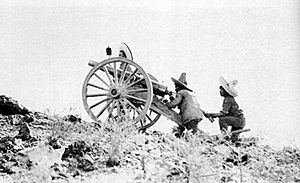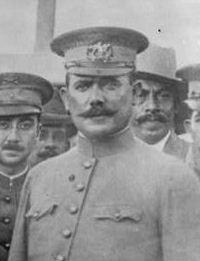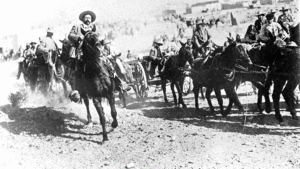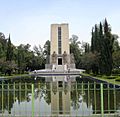Battle of Celaya facts for kids
Quick facts for kids Battle of Celaya |
|||||||
|---|---|---|---|---|---|---|---|
 Battle of Celaya in Guanajuato |
|||||||
|
|||||||
| Belligerents | |||||||
|
|
|
||||||
| Commanders and leaders | |||||||
| Strength | |||||||
| 15,000 13 big field guns |
22,000 | ||||||
| Casualties and losses | |||||||
| 695 killed 641 wounded |
6,000 killed 6,500 captured 5,000 wounded |
||||||
The Battle of Celaya was a very important fight during the Mexican Revolution. It happened between April 6 and 15, 1915, in Celaya, Guanajuato, Mexico. This battle was a big part of a series of fights in a region called the Bajío.
The battle was between two main groups: the Constitutionalists, led by General Álvaro Obregón, and the División del Norte (Division of the North), led by Pancho Villa. These two generals had once been allies, fighting against a leader named Victoriano Huerta. But after Huerta was defeated, they started fighting each other to control Mexico. The battles at Celaya were key in deciding who would win the Mexican Revolution.
General Obregón was very smart. He chose the battlefield carefully and got his army ready. He knew that Pancho Villa liked to make big, fast attacks with his cavalry (soldiers on horseback) across open fields. Obregón used a defensive plan. He used new fighting methods from World War I, like digging trenches, setting up barbed wire, and using many machine guns. Villa, on the other hand, kept using his old tactic of large cavalry charges.
Villa's army was much bigger than Obregón's, almost twice as large. But Obregón tricked Villa into fighting far from his supply lines. Villa's defeat was due to his mistakes and being too confident. After Celaya, Obregón and Villa fought two more big battles in the Bajío region, at León and Aguascalientes. These battles together sealed the victory for the Constitutionalists. Villa lost many soldiers and was no longer a major power in the revolution.
Contents
Key Leaders and Their Armies


The main leader for the Constitutionalists was General Álvaro Obregón. He didn't go to a special military school, but he learned a lot about fighting. He joined the army in 1912 and quickly became a skilled commander. Obregón was known for being smart and always learning about new military ideas and technology. He often listened to his military advisers, like Colonel Maximilian Kloss, a German immigrant. Kloss's advice about Villa's fighting style was very helpful at Celaya.
Pancho Villa, on the other hand, was not formally educated and had never been in a professional army. He was a great horseman from his early days. Villa liked to use his cavalry because they were fast. His army, the División del Norte, was very powerful and had never lost a major battle before Celaya. Villa also had a smart advisor, General Felipe Angeles, who was a trained officer. Angeles often thought Villa was too quick to attack without enough planning.
Villa's army also included many camp followers. These were people like soldiers' families and refugees who traveled with the army. While they provided support, they also sometimes slowed down Villa's forces.
Obregón knew that if he could get Villa to fight a big, decisive battle, he could defeat him completely. Villa's advisor, Felipe Angeles, tried to tell Villa to avoid such a big fight, but Villa didn't want to seem weak. Obregón's soldiers used barbed wire and other obstacles to slow down Villa's forces. This forced Villa's men into areas where Obregón's machine guns were waiting.
Before the Battle Started
Pancho Villa was known for being very confident and sometimes reckless. He would rarely refuse a fight. Obregón knew this and often tried to make Villa angry and provoke him. Before the Battle of Celaya, Obregón even bragged that he would win. Villa, in turn, told a newspaper that Obregón wouldn't escape him this time.
Both commanders wanted a big battle to settle things. Obregón successfully tricked Villa into coming to the battlefield that Obregón had chosen in the Bajío. Villa's fighting style was old-fashioned, relying on direct attacks and cavalry charges. Obregón, however, was ready with modern tactics like trenches and barbed wire, which were being used in World War I.
The First Battle of Celaya
Getting Ready for the Fight
Obregón's main plan was to get Villa's army far from its supply lines. He also wanted to choose the best place for the battle. Obregón's own supply lines were shorter, which was an advantage. Obregón's soldiers arrived at Celaya almost a month before the battle. By early April, he had about 6,000 cavalry, 5,000 infantry, 86 machine guns, and 13 big cannons.
Villa planned to use his cannons to weaken Obregón's defenses. But his main plan was a direct attack with his cavalry and infantry at dawn on April 6, 1915. Villa had not even looked at the battlefield himself. He was sure his large army could break through any defenses. But Obregón's men had cleared areas for their machine guns to shoot easily. They also improved ditches and small canals to use as trenches for cover.
Both armies had a big problem: they didn't have enough ammunition (bullets and cannon shells). This was partly because of the high demand during World War I. Some of the ammunition Villa bought was even faulty. Also, Obregón's army had more cannons, and their European-made ammunition was better and could shoot farther. Villa knew he was low on ammunition before the battle.
The Battle Begins
After Obregón's forces took their positions on April 4, 1915, they knew Villa's army was close. As Obregón's troops got their defenses ready, Villa's forces started moving towards Celaya on April 5. Obregón sent a small group of 1,500 men to attack Villa's railway lines. This was a mistake because most of Villa's army was already nearby and attacked this small group.
When Obregón heard about the fight, he quickly went to help his men. He then realized this mistake could be a perfect trick to lure Villa's main army into his prepared defenses. Obregón ordered his men to retreat. Villa's soldiers fell for the trick and chased the Constitutionalists back to their strong positions at Celaya.
When Villa's army attacked Obregón's defenses, they were stopped by machine guns and cannons. Instead of trying to go around the defenses, Villa ordered his troops to attack directly, wave after wave. Obregón later remembered that Villa's men attacked almost 40 times. Only once did they manage to break through. But Obregón quickly ordered his bugler to sound a general retreat. Villa's soldiers, thinking the order was for them, also retreated, giving up the ground they had just won. As Villa's men pulled back, Obregón ordered a strong counterattack.
Obregón also used his reserve forces, pushing Villa's men back even further. To make things worse for Villa, one of his commanders switched sides and started firing on Villa's own troops. With smart decisions and some luck, Obregón won the first Battle of Celaya.
After the First Battle
The first battle didn't completely destroy either side. But it was the first major defeat for Pancho Villa as a commander. Even so, Villa's soldiers still had high spirits and were ready to fight again. Villa blamed his defeat on not having enough ammunition. However, he also made mistakes by not keeping a reserve force and by fighting on the battlefield Obregón had chosen.
Villa's staff knew they needed to either go around Obregón's defenses or force him out. Villa even sent a letter to Obregón asking him to leave Celaya to protect civilians. But Obregón refused, knowing Villa just wanted him to give up his strong position.
The Second Battle of Celaya
Getting Ready Again
Both armies got more supplies as best they could, knowing another battle was coming. Ammunition was still low for everyone. Obregón guessed that Villa would not try to go around his defenses. So, Obregón ordered his men to put even more barbed wire in front of their positions. He also hid a large cavalry force of nearly 6,000 men in a nearby wooded area, led by General Cesareo Castro. Villa's forces didn't see them.
Obregón's men were confident after their first victory. Villa, on the other hand, felt his reputation was at stake. Even though his army was low on ammunition, had low morale, and was at a disadvantage, Villa prepared to attack again.
The Second Fight
The second Battle of Celaya began on April 13, 1915. Villa's cavalry launched a huge direct attack on Obregón's defensive lines. Just like in the first battle, Obregón's machine guns pushed them back again and again. Villa's cavalry and infantry kept attacking for almost two days, but they were defeated every time. Even after Villa's cannons tried to weaken the defenses, Obregón's lines held strong.
However, Obregón's army was also running very low on ammunition. After days of fighting, their situation was dangerous. Obregón sent an urgent message to President Carranza on April 14, saying they only had enough bullets for a few more hours. Carranza immediately sent a train full of ammunition to Celaya. This new supply was crucial for Obregón to keep fighting Villa's large army.
As Villa's troops were tired after nearly 48 hours of fighting, Obregón launched his hidden cavalry force from the north. This counterattack was devastating for Villa's army, and they began a full retreat. Obregón ordered his forces to chase Villa's men completely off the field, securing a total victory.
After the Second Battle
Villa and his main commanders managed to escape, but Obregón had won a huge victory. Many of Villa's lower-ranking officers were captured or surrendered. Obregón ordered all 120 captured officers to be executed. The Constitutionalists also captured thousands of weapons, ammunition, horses, and valuable cannons from Villa's army.
What Happened After the Celaya Battles
After the battle, Obregón sent a message to President Carranza, saying, "Fortunately, Villa led the attack personally," meaning Villa's mistakes helped Obregón win. The Battle of Celaya is sometimes called Pancho Villa's "Waterloo" because it was such a terrible defeat for him. It greatly damaged his military power and his reputation for being unbeatable. Many people, both in Mexico and other countries, then believed that Villa's army could not defeat the Constitutionalists.
Militarily, Villa's forces were never as strong again after Celaya. Villa had to go on the defensive and try to rebuild his army and get new supplies. His loyal advisor, General Felipe Angeles, suggested that Villa should go back to northern Mexico, where he had allies.
However, Villa, still confident, decided to fight a defensive battle at León, similar to what Obregón had done at Celaya. Obregón continued to pursue Villa in later battles. At the Battle of León, Obregón lost his right arm and almost died.
The Battle of Celaya took place near the modern city of Celaya, Guanajuato, Mexico. There isn't a big monument or museum at the battlefield today. In Mexico City, there is a monument to Obregón where he was killed in 1928.
The Battle of Celaya was Villa's last major contribution to the civil war. He was no longer a powerful leader. Because of this, the United States started to support the winning Constitutionalists, and Villa was forced to go on the run.
Images for kids
See also
 In Spanish: Batalla de Celaya para niños
In Spanish: Batalla de Celaya para niños


